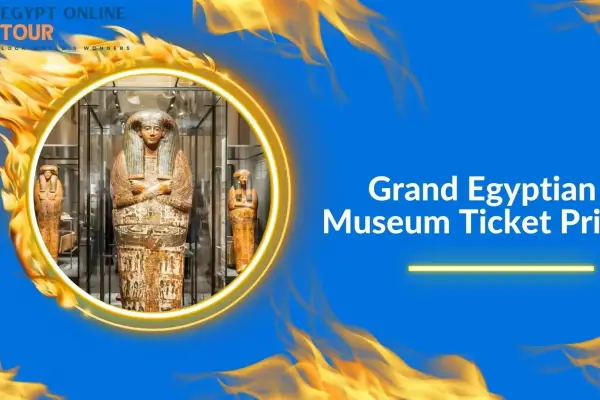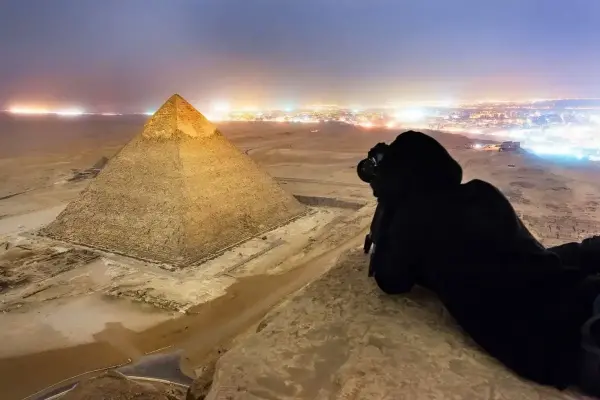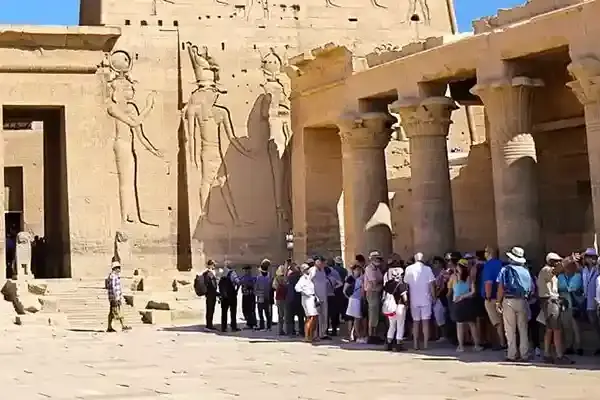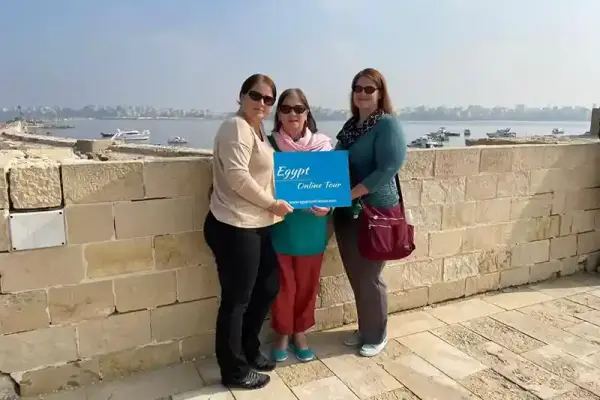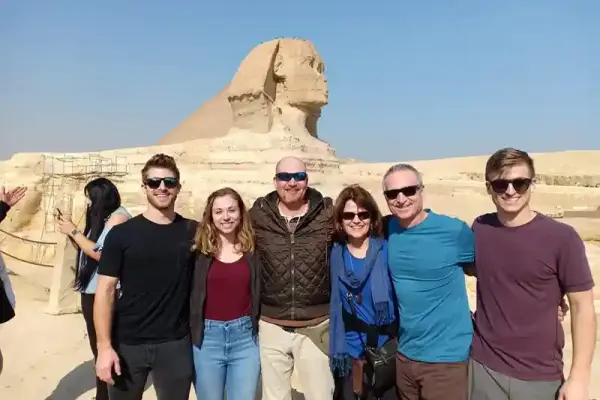The Abu Simbel Sun Festival is an artistic and astronomical phenomenon that highlights the ancient Egyptians' genius, advanced knowledge of astronomy and geography.
In the temple, the sun's rays shine through a 60-metre-long corridor and light up the Holy of Holies where there are statues of Ra-Horakhty, Ramses II, and Amun-Ra. The statue of the Ptah (the god of darkness) will be in shadow only two days a year.
In this article, we will write about everything related to the significant Abu Simbel Festival. Please follow along.
Table of contents [Show]
- Abu Simbel Sun Festival History
- What happens during the Abu Simbel Sun Festival?
-
What time is the light show at Abu Simbel?
- The difference between the February (coronation day) and October (birth day) alignments
- The standard
- February 22 (coronation)
- October 22 (birth)
- Historical symbolism
- This is believed to be the date of the coronation of Ramses II as king of Egypt.
- This is believed to be the date of Ramses II's birth.
- The astronomical position of the sun
- The sun is in Pisces (near the vernal equinox)
- The sun is in Libra (near the autumnal equinox).
- The light angle
- The sun enters at a lower angle.
- The sun enters at a slightly higher angle.
- Tips for Attending
- Best Viewing Spots
-
Abu Simbel Sun Festival
- The Legacy of Ramses II: Power Carved in Stone
- The Temples of Abu Simbel: Divine Architecture
- The Small Temple of Queen Nefertari
- The Sun Festival Phenomenon: Where Astronomy Meets Divinity
- Abu Simbel Sun Festival 2025
- A Second Miracle: The Temple That Moved Mountains
- Book Your Journey with Egypt Online Tour
- What do they eat at the Abu Simbel festival?
- Abu Simbel sun festival tickets
- Best Tours to Abu Simbel Sun Festival – Exclusive Travel Deals with Egypt Online Tour
- How Was Abu Simbel Saved from Near Destruction?
- Conclusion
Abu Simbel Sun Festival History
The Abu Simbel Sun Festival began with the construction of the temple during the campaign of King Ramses II (c. 1244 BC - 1224 BC) more than 3,200 years ago. The temple texts document that Ramses II built the temple as a "royal house forever" and the decorations and astronomical architecture upon its construction were oriented perfectly to align with the sun's position. After it was discovered in 1813 and restored from the sand where it lay, scientists witnessed the sun's alignment phenomenon through the temple, and it has been declared an annual festival and is now celebrated as part of Egyptian history and cultural tourism in the last century.
But why was the temple built in this specific location?
The site of Abu Simbel was no accident. The site has been specifically chosen to align with the sun's movement, and Ramses II purposely identified the main axis of the temple so that sun rays would penetrate the Holy of Holies two times a year. Furthermore, the temple is located near Nubia (southern Egypt) as a show of strength to Ramses II enemies. It was also dedicated to Amun-Ra (the sun god), Ra-Horakhty, Ptah, and to Ramses II himself (deified).
Religious Holidays, Astrology, and the Ancient Egyptian Calendar
The ancient Egyptian calendar: It was based on 365 days (12 months x 30 days + 5 intercalary days), closely linked to the Nile flood and the movements of the stars (especially Sirius).
Religious Holidays and Astronomy:
- The Egyptians associated holidays with astronomical phenomena such as the equinoxes and solstices.
- The Feast of Ramesses II: The day of the solar alignment (February 22 and October 22) was believed to coincide with the king's birthday and coronation, strengthening his legitimacy as a god-king.
- Astrology: The temple's decorations were associated with the constellation Leo (a symbol of Ra-Horakhty), indicating a precise understanding of the movement of celestial bodies.
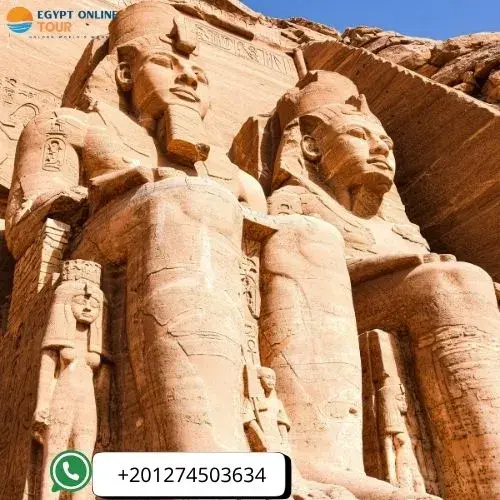
The astronomical miracle behind the sun's two-year perpendicularity
- February 22: The coronation day of Ramses II
- October 22: His birthday.
The sun's rays penetrate the 60-meter-long temple corridor to reach the Holy of Holies, illuminating the statues of Ra-Horakhty, Ramesses II, and Amun-Ra, while the statue of Ptah (the god of darkness) remains in shadow.
If the temple had been built a few degrees further from its current location, the alignment would not have been so precise. This alignment is linked to the position of the sun in Leo (a symbol of royal power) and the angle of inclination of the temple's axis with the equator.
The Abu Simbel Festival is not just a tourist attraction; it is an astronomical and engineering masterpiece that reflects the ancient Egyptians' genius in linking religion and science. The sun's alignment is evidence of precise astronomical knowledge, and the selection of the location and angles was not a coincidence, but the result of careful calculations spanning thousands of years.
What happens during the Abu Simbel Sun Festival?
Every year, on February 22 and October 22, an amazing astronomical phenomenon occurs inside the Temple of Ramses II:
- Before sunrise, Hundreds gather in front of the temple awaiting the magical moment.
- Sunrise (approximately 5:50 AM): The sun's rays begin to penetrate the long (60-meter) corridor of the Abu Simbel Temple.
The Golden Moment (6:00-6:20 AM):
- The sun illuminates the statues of the Holy of Holies (Ra-Horakhty, Ramses II, and Amun-Ra) with a golden light, while the statue of Ptah (the god of darkness) remains in darkness.
- The phenomenon lasts only 20 minutes, making it rare and awe-inspiring.
Symbolic Significance: The ancient Egyptians believed this phenomenon confirmed the gods' approval of the king and the renewal of his divine energy.
Learn more about: What to do in Aswan Egypt
Scene and Ceremonial Rituals
Thousands of tourists, archaeologists, and astronomy enthusiasts from all over the world attend.
Modern Rituals:
- Formal Ceremonies: Speeches are delivered by Egyptian officials and archaeologists.
- Light Shows: Dim lights are used to enhance the beauty of the phenomenon without distorting it.
- Chanting and Clapping: When the sun appears, the audience applauds with joy at this historic spectacle.
Popular Participation:
- Some visitors dress in pharaonic costumes or raise Egyptian flags in celebration of their heritage.
- Traditional Nubian drumming and singing are heard.
Traditional Music and Dances:
- Nubian bands perform songs such as "Amun-Ra" and dance in colorful Nubian costumes.
- Pharaonic Folklore: Pharaonic costume performances with music based on harps and tambourines.
Exhibitions and Handicrafts:
- A heritage market featuring.
- Small statues of Abu Simbel.
- Pharaonic-inspired jewelry.
- Nubian products such as baskets and traditional ornaments.
- Photographic Exhibitions: Showcasing rare images of the sun's alignment throughout history.
Workshops and Lectures:
- Lectures on Ancient Egyptian Astronomy: Experts explain how the Egyptians determined the timing of the solar alignment.
- Art Workshops for Children: Such as making miniature models of the temple.
Sound and Light Shows
- Evening shows tell the story of Ramses II and the construction of the temple using dramatic lighting and sound effects.
Why is this festival unique?
- A combination of science and heritage: A precise astronomical event celebrated as a cultural heritage.
- A spiritual visual experience: Watching the sun illuminate the statues makes you feel as if you've traveled back in time to the era of the Pharaohs.
- A lively celebration: A blend of history, art, and popular participation.
If you visit Abu Simbel on these two days, you'll witness one of the greatest natural spectacles engineered by humans thousands of years ago with the best Egypt Budget Tours.
What time is the light show at Abu Simbel?
The Abu Simbel Festival is a unique astronomical event that has been calculated with precision for the past 3,300 years. Research in astronomy (especially by Dr. Mohamed Youssef, an astronomical archaeologist) purports that the geometric axis of the temple was specifically designed to align with the sunrise angle on these two days. This phenomenon of the sun perpendicular to the Holy of Holies in the Temple of Ramses II happens twice a year:
- February 22 (possibly the anniversary of Ramses II's coronation)
- October 22 (probably the anniversary of his birth).
For Abu Simbel, sunrise can vary from about 5:50 a.m. to 6:00 a.m. depending on the day. The rays of the sun enter the inner corridor of the temple around 6:00 a.m.
The ultimate majesty occurs between 6:15 and 6:25 a.m., the actual pinnacle of the breathtaking event when the three statues (Ra-Horakhty, Ramses II, and Amun-Ra) are illuminated. This occurrence lasts about 20 minutes before the sun starts to move.
Scholars also noted that if the temple's construction had any small deviation measures (even a couple of centimeters), the alignment would not have been so exact.
Learn more about: Best time to travel to Egypt
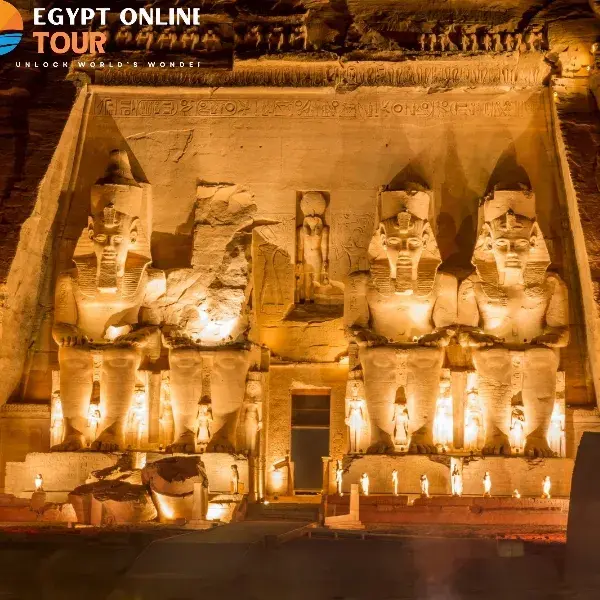
The difference between the February (coronation day) and October (birth day) alignments
The standard | February 22 (coronation) | October 22 (birth) |
Historical symbolism | This is believed to be the date of the coronation of Ramses II as king of Egypt. | This is believed to be the date of Ramses II's birth. |
The astronomical position of the sun | The sun is in Pisces (near the vernal equinox) | The sun is in Libra (near the autumnal equinox). |
The light angle | The sun enters at a lower angle. | The sun enters at a slightly higher angle. |
The number of visitors is less crowded compared to October (lower tourist season). | More crowded (coincides with higher tourist season).
|
Some researchers (such as Selim Hassan) suggest that the dates may be related to other events, such as agricultural festivals or ancient solstices.
Tips for Attending
- Arrive before dawn, as Abu Simbel opens before 4:30 a.m. on festival day. Arriving before 4:00 a.m. guarantees you a good spot.
- Tickets sell out quickly, so it's best to purchase them online in advance through Egypt Online Tours, the most trusted company.
- February is less crowded than October, so if you want a quieter time, choose February 2026.
Best Viewing Spots
- Inside the Holy of Holies: The best, but capacity is limited (only 300 people are allowed at a time).
- In front of the temple: Where the phenomenon is broadcast on large screens to the outside audience.
- High Platforms: Some organizers set up viewing platforms for photography.
- Use a wide-angle lens to capture the sun as it enters the temple.
- Avoid flash, as it spoils the spiritual atmosphere of the event.
Abu Simbel Sun Festival
Welcome to one of the greatest landmarks of ancient Egyptian civilization - the temples of Abu Simbel! This UNESCO World Heritage site is a jaw-dropping example of how stunning engineering, vast spirituality, and powerful politics all come together in the ancient Egyptian civilization to serve the Pharaohs. Here in deep southern Egypt, on the west bank of Lake Nasser, Pharaoh Ramses II carved his mark in stone… and in history.
Abu Simbel is not just a temple - it is a statement of perpetual power, carved in light and shadow." Zahi Hawass - world-renowned Egyptologist
The Legacy of Ramses II: Power Carved in Stone
Imagine arriving at the southern border of ancient Egypt, around the 13th century BC. Before you, as you step into the golden sands, you behold not one but four massive seated statues, each over 20 meters (65 feet) tall — about the height of a six-story building. These are the statues of the Great Temple of Ramses II, which was carved into the sandstone cliffs themselves.
These statues are much more than statues — they are a message of political intent to every person who approaches the temple from the south:
"This is my land, and this is my glory!" Ramses II (through architecture)
The temples were carved between about 1264–1244 BC, and not only were they intended to impress the gods, but also the southern neighbors of Egypt in Nubia. Ramses chose Abu Simbel as a symbolic frontier — a psychological and spiritual stronghold.
The Temples of Abu Simbel: Divine Architecture
The complex consists of two temples:
The Great Temple of Ramses II
Dedicated to the powerful gods Amun-Ra, Ptah, and Ra-Horakhty, the temple glorifies Ramses himself as a god among gods. Its walls are adorned with scenes from the Battle of Kadesh, the largest chariot battle ever fought in ancient history, where Ramses claimed a dramatic (if debated) victory over the Hittites.
Inside, a colossal 33-meter (108-foot) hallway leads deep into the temple… to the Sanctuary of Light.
The Small Temple of Queen Nefertari
Just beside the Great Temple, a smaller but equally magnificent structure honors Ramses’ beloved queen Nefertari, and the goddess Hathor. Unique among Egyptian monuments, Nefertari’s statues are carved at equal height to those of the pharaoh — a clear symbol of her elevated status.
"This equality in scale is not only rare; it’s revolutionary for its time." Dr. Salima Ikram, Egyptologist
The Sun Festival Phenomenon: Where Astronomy Meets Divinity
Twice a year — on February 22 and October 22 — the sun aligns with stunning precision through the temple’s axis. For just a few minutes, sunlight travels 63 meters deep inside the Great Temple to illuminate three statues:
- Ra-Horakhty – God of the Sun
- Ramses II – The deified Pharaoh
- Amun-Ra – King of the Gods
Only Ptah, god of the underworld, remains shrouded in darkness — by design respecting his association with the unseen.
This solar alignment, calculated over 3,200 years ago without modern tools, continues to astonish scientists and visitors alike.
"It’s a celestial calendar carved into stone." NASA researchers, commenting on ancient Egypt’s astronomical accuracy
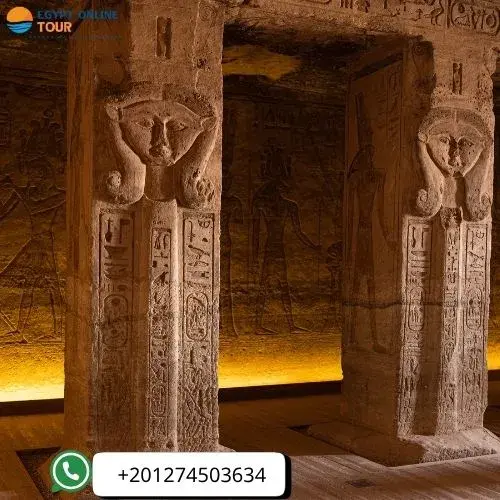
Abu Simbel Sun Festival 2025
On these sacred mornings, thousands of spectators from around the world gather in awe. As the first golden beam of sunlight strikes the statues, silence turns into celebration: traditional Nubian music, vibrant folklore dances, local handicrafts, and delicious Egyptian cuisine bring the festival to life.
The Sun Festival is more than a show. It’s a spiritual, astronomical, and artistic marvel — one of the few global events where nature, science, and mythology converge in real-time.
A Second Miracle: The Temple That Moved Mountains
In the 1960s, as the waters of Lake Nasser rose due to the construction of the Aswan High Dam, the temples were under threat of submersion. In a historic UNESCO-led campaign, the entire complex was dismantled and relocated 65 meters higher and 200 meters inland.
Over 2,000 stone blocks, each weighing up to 30 tons, were moved in an engineering feat that took four years (1964–1968) and cost more than $40 million (equivalent to over $300 million today).
"It was the greatest archaeological rescue operation in history." UNESCO official report, 1970
Why Visit Abu Simbel in 2025?
- Witness the Sun Festival with expert guides
- Explore untouched Nubian culture and local markets
- Enjoy seamless travel with Egypt Online Touro
- Capture history and magic in a once-in-a-lifetime trip
Next Festival Dates:
- October 22, 2025 – Ramses' Birthday
- February 22, 2026 – Ramses' Coronation Day
Book Your Journey with Egypt Online Tour
Don’t miss this opportunity to be part of a millennia-old tradition. Let Egypt Online Tour take you on an unforgettable journey to one of the most iconic temples in human history.
Learn more about: How to Plan a Family Vacation in Egypt from USA
Let our local travel experts help you design the perfect itinerary. Whether you're seeking adventure, culture, or relaxation, we've got you covered!
What do they eat at the Abu Simbel festival?
The festival features many traditional and historical dishes, both Nubian and Egyptian. Here are the most important:
The most famous traditional Nubian dishes at the festival
The festival features authentic Nubian dishes that reflect the culture of the people of the south, including:
1. Nubian Kurash
Ingredients: Thin bread made from corn or wheat flour, served with black honey or yogurt. It is mentioned in the book "Dietary Customs of the Nubians" (Dr. Ahmed Morsi) as a staple food at special occasions.
2. Nubian Lentil Soup (Adassi)
Ingredients: Red lentils, garlic, turmeric, and special Nubian spices. It is served at celebrations as a symbol of blessing, according to traditions recorded at the Nubian Museum.
3. Nubian Fatta
Ingredients: Rice, toasted bread, lamb, and garlic. This is a festive dish mentioned by the 19th-century traveler Richard Lepsius as part of Nubian feasts.

Popular Egyptian Dishes at the Festival
In addition to Nubian dishes, famous Egyptian dishes are served:
- Egyptian Koshari: This popular dish is sold at the festival as a fast food meal for visitors, especially those from Cairo.
- Feseekh and Herring (February only): Feseekh has been eaten at festivals since the Pharaonic era (as mentioned by Herodotus).
- Black honey with tahini: This is considered one of the oldest Egyptian foods, as depictions of honeybees have been found in the temples of Luxor.
At the festival, visitors sit on traditional mats to eat communally, as in Nubian brides. Nubian pottery dishes and qellal cups (made from palm fronds) are used.
Researcher Frank Henry documents in his book "Nubia: The Land and the People" how food serves as a means of preserving identity.
"Nubian food is a gateway to understanding a civilization thousands of years old." — Dr. Mohamed Abou El-Ghar, Anthropologist.
The festival's food is unique, as it uses the same ingredients used by the ancient Pharaohs and Nubians. It's a blend of Nubian and Egyptian influences, and the festival wouldn't be complete without sampling these dishes. We also recommend trying a full Nubian meal while watching the sunset over the Temple of Ramses II.
Read about: Top 10 most common foods in Egypt
Abu Simbel sun festival tickets
If you're dreaming of witnessing the magical moment when the sun's rays align perfectly with the sacred statues inside Abu Simbel Temple, securing your ticket in advance is essential. The Abu Simbel Sun Festival, held twice a year on February 22 and October 22, attracts thousands of visitors from around the globe, and tickets tend to sell out quickly.
How to Book Your Abu Simbel Sun Festival Tickets
Booking your tickets has never been easier with Egypt Online Tour, your trusted partner for authentic and well-organized travel experiences in Egypt. You can reserve your seat for the festival through:
Our official website:
All tickets include entry to the temple complex and access to the main viewing area where the sunlight event is observed.
Are There VIP Tickets Available?
Yes! For those seeking a more exclusive and comfortable experience, we offer VIP packages that include:
- Front-row seating near the entrance of the temple
- Private transfers from Aswan or your hotel
- Early morning breakfast box and refreshments
- Fast-track temple access with a professional Egyptologist guide
- Access to VIP lounge tents with local performances
VIP tickets are limited and must be booked well in advance, especially for the October and February peak festival dates.
Average Ticket Prices & Inclusions
Prices vary depending on the package you choose:
Ticket Type | Price (USD) | Inclusions |
Standard Entry | $25–$35 | Entry to Abu Simbel temple site
|
Festival Group Tour | $90–$120 | Entry ticket + round-trip transport from Aswan + local guide |
VIP Package | $250–$350 | All of the above + private transfer + front-row access + meals
|
Note: Prices are subject to change based on demand and time of booking. Group discounts are available.
Do Tickets Include Transport & Accommodation?
Some of our packages do include transport from Aswan (either by road or by flight), while others are ticket-only. You can also upgrade to full experience bundles that include:
1-night accommodation in a Nubian guest house near Abu Simbel
- Sunset Felucca ride in Aswan
- Early morning private transport to the site
- Guided tours in multiple languages
For the best value, Egypt Online Tour recommends booking an all-inclusive festival tour, which guarantees the full magical experience without the stress of logistics.
Ready to witness the miracle?
Book your tickets now for the 2025 Abu Simbel Sun Festival and let us take care of the rest. With Egypt Online Tour, your best Egypt Adventure Tours to the heart of ancient Egypt will be unforgettable. Book Now on Egypt Online Tour
If you want to visit cairo also don't wait to know about: Grand Egyptian Museum Ticket Price
Best Tours to Abu Simbel Sun Festival – Exclusive Travel Deals with Egypt Online Tour
Looking to experience the Abu Simbel Sun Festival in the most immersive and well-organized way possible? At Egypt Online Tour, we offer exclusive travel packages tailored for every type of traveler—from history enthusiasts to photographers and families. Our tours are designed to combine comfort, cultural depth, and unforgettable moments during one of Egypt’s most unique festivals.
When Is the Best Time to Book?
To secure the best views and accommodations, we strongly recommend booking at least 2–3 months in advance, especially for:
- February 22 (celebrating Ramses II’s coronation)
- October 22 (marking his birthday)
These dates see a surge in international attendance, and our early-bird packages often sell out quickly!
We cant wait to see you so book your Egypt tour packages now and enjoy with your amazing journey

Why Book with Our Egyptologists?
Unlike generic tours, our guides are certified Egyptologists with deep knowledge of ancient Egyptian astronomy, art, and symbolism. This means you’ll get:
- Detailed interpretations of temple carvings
- Insider stories about Ramses II and Queen Nefertari
- Context on the astronomical alignment behind the festival
- Answers to your questions in your preferred language (English, French, German, Arabic, and more)
Booking with specialized guides transforms the experience from a sightseeing tour into a journey through time.
Optional Add-Ons to Enrich Your Trip
Maximize your trip by adding:
- A guided tour of Philae Temple, dedicated to the goddess Isis—reachable by boat
- The Nubian Museum, showcasing rare artifacts and Nubian heritage
- A relaxing felucca ride at sunset on the Nile in Aswan
- A traditional Nubian dinner and cultural performance
We also offer customizations for photography groups, students, or spiritual travelers seeking meditation moments inside the temples.
Whether you're looking for a quick getaway or an in-depth exploration, our Abu Simbel Sun Festival Luxury Egypt Tours promise an awe-inspiring experience. Book now with Egypt Online Tour to secure your spot before tickets sell out.
If you want to come to Egypt you need to know more about: What are the important holidays in Egypt
How Was Abu Simbel Saved from Near Destruction?
A Global Engineering Miracle to Preserve Ancient Egypt’s Glory.
When the High Dam of Aswan was constructed in the 1960s, the rising waters of Lake Nasser posed a serious threat to some of the most treasured temples in human history—most notably the Temples of Abu Simbel, which risked being permanently submerged.
Rather than losing these irreplaceable monuments, the world responded with an unprecedented mission.
The Threat: Submersion by Lake Nasser
After the High Dam was completed, water levels in southern Egypt began to rise at an alarming rate, threatening to completely drown the Abu Simbel temples, carved into the sandstone cliffs over 3,200 years ago by Pharaoh Ramses II.
UNESCO to the Rescue
In 1960, UNESCO launched the first international campaign to save endangered cultural heritage, calling on the world for assistance. The campaign was a monumental success, with over 50 countries contributing funds, expertise, and logistical support.
This was the first and largest archaeological rescue operation in history, and it became a symbol of international unity for cultural preservation.
The Move: Engineering Feat of the Century
- Between 1964 and 1968, engineers and archaeologists undertook a jaw-dropping operation:
- The two temples were cut into over 1,000 massive blocks, each weighing up to 30 tons
- Every block was numbered, cataloged, and carefully transported uphill to a new, safe location 65 meters higher and 210 meters back from the river
The interiors, wall carvings, and astronomical alignment were preserved with pinpoint precision, ensuring that the Sun Festival light phenomenon would still occur exactly as it did for Ramses II
By the numbers:
- Over 1,036 blocks cut and reassembled
- 4 years of continuous work
- Total cost: over $40 million USD at the time (equivalent to hundreds of millions today)
- Hundreds of engineers, archaeologists, and laborers from all over the world
- A Turning Point in World Heritage
The Abu Simbel relocation set a new standard in heritage preservation. It led to the founding of the World Heritage Sites program, and since then, UNESCO has coordinated over 20 major rescue projects globally.
This mission wasn’t just about saving a monument—it was about saving human history.
When you stand in front of Abu Simbel today, you are not only witnessing Pharaonic greatness, but also one of the greatest acts of modern human cooperation. It’s more than a visit—it’s a celebration of global heritage.
Book your Egypt Classic Tours with Egypt Online Tour and become part of the story.
Conclusion
The Abu Simbel Sun Festival isn’t just an ancient light show — it’s a once-in-a-lifetime experience where history, science, and spirituality align in one breathtaking moment. From the genius of astronomical precision to the incredible global rescue operation, Abu Simbel remains a living legend of human greatness.
Whether you're drawn by the mystery of the pharaohs, the legacy of UNESCO’s historic mission, or the energy of Egypt's most unique festival, your journey begins here.
Egypt Online Tour offers you expertly crafted tour packages, exclusive access to the festival, Egyptologist-guided visits, and seamless logistics — from transportation to accommodation.
Spaces fill up months in advance, especially for the Sun Festival in February and October.
Book now with Egypt Online Tour and step into 3,200 years of wonder.
Frequently Asked Questions
1 What celebrations go on outside at the Abu Simbel Festival? ▶
2 What is so special about Abu Simbel? ▶
3 What are the 4 statues in Abu Simbel? ▶
Popular Categories
Related properties
Cairo, Aswan, and Luxor
-
Precio
$ 2,850
-
Tipo
Package
Cairo, Aswan, and Luxor
-
Precio
$ 1,850
-
Tipo
Package

